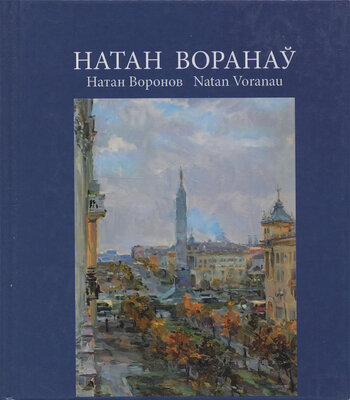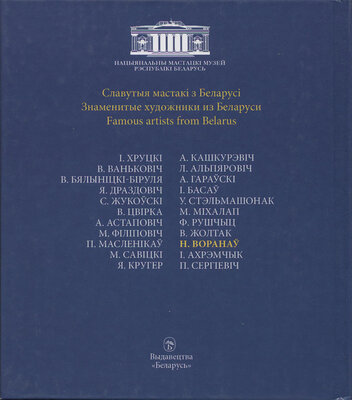Натан Воранаў
Выдавец: Беларусь
Памер: 99с.
Мінск 2016
Natan Voranau paid great attention in his creative work to the depiction of global changes that were going on in the country and were altering the image of the republic. His painting Mine Builders of Belorussia (1961) stands out among other works on the topic of modernity painted by the artist both in the image and composition and in painting. Natan Maiseevich conveyed in the painting the spirit of that time — colossal construction work that engulf the whole country. In this case, new buildings do
5Воранаў, H. Дзівосны сцяг / H. Воранаў П Работніца і сялянка. — 1960. — № 10. — С. 8.
not suppress figures of the workers. “Stability and balance of the composition is still more highlighted by diverse poses of the builders and successfully found correlation between the figures and different mechanisms of the building site”6. The theme of modernity is also embodied through the selection of the character types of the builders and through the thoroughly elaborated composition of the painting. Painting aspect of the given canvas is distinctive of expressive, dynamic strokes and free forms.
The war events that had already become the history thrilled N. Voranau all his career. The artist treated this theme with particular awe. He nurtured a plan for each painting on the war theme for a long time. The artist noted: “As four years at the front helped me to work at the characters for the paintings about October and the Civil War, I hope that the experience of the work at the themes of peace and victory will help me to approach one more time the theme of the Great Patriotic War...”7. While working on the war theme, he first of all strived to create an impression principally avoiding the direct illustration of events. “A painting-impression is that how I imagine a modern painting about the Great Patriotic War. We all came to the same conclusion. It is good to work surrounded by talented colleagues... The Vitsebsk Gate by Mikhail Savitsky tells a lot to my heart... Or take paintings by Mai Dantsyg... His Partisan Wedding is an essential success. These are paintings-impressions...”8.
In 1973, N. Voranau created the painting To the Memory of Fellow Soldiers of Nineteen Forty One. An elongated horizontal format, a high horizon line, a thin strip of the low winter dawn sky and three figures of soldiers wandering through high snowdrifts in the foreground. At the same time, it is impossible to distinguish the soldiers’ faces — they are hidden in the shadows. Natan Maiseevich concentrated all attention on details, nuances that let feel the war atmosphere, mood and time. The means of artistic expressiveness submit to the main idea to create the painting-impression with a deep metaphorical meaning.
During his career, Natan Voranau created a whole gallery of portraits of his contemporaries: people of labour, best workers, sportsmen, workers of science and art. There are more than thirty such canvases only in the National Art Museum of the Re
6Бадин, P. Г. Натан Моисеевич Воронов I P. Г. Бадин. — Минск: Беларусь, 1979. — С. 7.
7 Бойко, В. Перед мольбертом [Электронный ресурс] / В. Бойко. — Режим доступа: http: II voronov.by I gazety. — Дата обращения: 02.08.2016.
‘Бойка, У. А. Беларуская палітра дваццатага стагоддзя. — С. 101.
public of Belarus. To paint practically all of them, the artist firstly made preparatory studies from life, visited peoples workplaces, personally talked to them. And a person opened his heart in a conversation with a friendly and open artist. It was important for Natan Maiseevich not only to create images of the best representatives of the Soviet people worthy to be looked up to, but also to accentuate an individual character of each of them.
In 1949, Natan Voranau had a creative trip to Kuibyshev. There, he painted a number of portraits of outstanding people of Volga region for the All-Union Picture Exhibition dedicated to the 32nd anniversary of October Revolution (in the museum collection — Captain of the Flagship Steamer “Ruslan” Major Bukaev P. S. and Portrait of Trubkin M. V., Winner of the State Award, Senior Master of Kuibyshev Hydroelectric Power Station). He found the right pose, surroundings and colours for everyone. Already in those early independent works the artist developed his main artistic principles, which he would use in the future bright individual works. He would paint a lot of portraits of people of different professions. Each portrait is a story about the personality, the person’s destiny and time (Portrait of a Girl, 1954; Portrait of Pylikau A. N„ Miner of Saligorsk Potash Plant, 1960; Portrait of Zyatseva V. A., Senior Laboratory Assistant of the Control Laboratory of Polotsk Refinery, 1963; On the Line, 1972; Midday. Portrait of Labour Veteran, Milkmaid V. A. Mikhailouskaya, 1975; Minsk Citizen. A Contemporary, 1976—1977; Traffic Police Captain L. Novak, 1977, etc.)
Natan Maiseevich enthusiastically painted also intellectuals (Portrait of Artist Barkhatkau A. S., 1955; Portrait of Pastunina T. M., Honoured Performing Artist of the BSSR (as Marpha in the opera The Tsar’s Bride by Rimsky-Korsakov), 1956; Portrait of Ramanovich Ya. S., Honoured Performing Artist of the BSSR, Playwright, 1962; Belarus Is My Song. Portrait of I. I. Zhynovich and V. A. Burkovich, 1970; Portrait of Yanka Kupala, 1972). Critics spoke highly about new works of the artist. His paintings were repeatedly discussed in newspapers. For example, in 1972, the BSSR State Art Museum (now, the National Art Museum of the Republic of Belarus) held an exhibition of works of Belarusian artists dedicated to the 90th anniversary of Peoples Artists Yanka Kupala and Yakub Kolas. P. Gerasimovich, head of the Belarusian Art Department of the BSSR State Art Museum, wrote: “A new painting created by artist Natan Voranau should be named as the most successful painting in the gallery of the images of Yanka Kupala. The artist highlights charm and kindness of Yanka Kupala,
his inner beauty that enchanted so much those around him. Surely, the artists luck was accompanied by the love for the literary legacy of the poet, the desire to express his own attitude to the poet in painting and to summarize to the best possible extent the feelings of those who cherish the poetic lines of Yanka Kupala”9.
A special place among the portraits by Natan Voranau take the canvases depicting artists daughter Maryna (Marynachka, Self-Portrait with the Daughter, both — 1956; A Little Octobrist, 1961; To Spring. Friends, 1967). The portraits are brimming with sincere parental love. In the painting Marynachka, a four-year girl is depicted with a large bow in the hair, in a pretty red dress and her best friend the teddy bear in her arms. It is clear that the outfit was specially selected for the posing. However, it feels that the child was a bit tired of sitting still and something distracted her. It was that moment when the artist finished the portrait. This turn of the head, an interested gaze to the side and the chubby baby mouth half-opened in surprise add to the naturalness and ease of the given portrait. The painting emanates affection and love. Grown up Maryna is depicted on the paintings A Little Octobrist and To Spring. Friends. In each canvas, the artist grasps and masterly shows various child emotions.
The principal moment in the portrait genre for the master was creation of an artistic image. Practically all works by Natan Voranau are devoid of prearrangement. At the same time, the artist always found for people accurate poses: they looked easy and natural for each model, every person was in the natural surroundings. The portraits are painted very lightly with wide dynamic strokes. The artist repeated many times that “it is necessary to convey the unity of the surroundings and the person in the portrait, otherwise it is impossible to show rightly the great and complicated theme in art”10.
Natan Maiseevich worked a lot in the landscape genre. Often going to creative trips to different corners of the huge country, travelling extensively by himself or with his students around Belarus, he by all means brought back rich materials for painting.
It is no secret that N. Voranau loved the art of Impressionists very much. At the times of his studies in Leningrad, he visited the State Hermitage with pleasure and examined canvases of the French masters for hours. He was fascinated at the apparent ease with which their works had been created, unique depiction of light and air, and, of course, the colour scheme — a real feast for the eyes. In the lyrical landsca
’ Герасимович, П. Источник вдохновения [Электронный ресурс] / П. Герасимович. — Режим доступа: http: И voronov.by / gazety. — Дата обращения: 02.08.2016.
10 Бадин, Р. Г. Натан Моисеевич Воронов. — С. 8.
pes of the artist, a simple everyday motif is often transformed by pervasive flexible light which add to the painting a sense of festivity and celebration of life (A Cloudy Day, 1946; Kavgolovo, 1948; On the Vast Expanse of the Volga, 1949; September, A Fishing Harbour, Riga Seaside, all — 1953; Flax, Sea. Boats, both — 1956; An Alley in the Park, 1958; Flowering Apricot, Noon on the Prypyat, both — 1959; Busy Season, 1959— 1961; A Windy Day, To Spring, Ripening Rye, all — 1962, Spring Has Come, A Sunny Day, both — 1963, Silence, 1965—1966; Blossomed, Before the Rain, both — 1973; Svetlogorsk on the Byarezina, 1975, etc.).
In the early 1960s, Natan Voranau visited Saligorsk on creative trips as many Belarusian artists. He created a whole series of industrial landscapes depicting the construction of the new city (Concrete Product Plant, Saligorsk Potash Plant, both — 1960 and others). The passage of time, changes in the image of Belarusian cities were captured by the artist in such paintings as Flood on the Byarezina, Noon (both — 1958), Draining Wetlands in Palesse (1960), Gomel. Port (1963), A Fishing Quay (1968) and others.
With a special feeling the artist painted views of his favourite Minsk that had literally risen from the ashes after the war and became one of the most beautiful cities in the USSR. N. Voranau dedicated to it such canvases as Minsk. Internatsiyanalnaya Street (1949), Minsk. Peramogi Square (1964), Uskhodnyaya (1968), A Road to Minsk (1972), At the Building Site, Waiting for Winter (both — 1973), etc. There were positive comments on the success of the artist in the press: “The paintings by N. Voranau are of interest, they explore the post-revolutionary history of Minsk, improvements on streets, parks and squares. The old merchant buildings of the Lower Market and new architectural ensembles of Peramogi Square illustrate a titanic work of the citizens of Minsk made for the renewal and transformation of their beloved city. The industrial theme takes a significant place in the work of the artist. The paintings Noon, Gomel Port, In the Foundry and others introduce to us the achievements of Belarus in 40 years of the Soviet power11.
 КНІГІ ОНЛАЙН
КНІГІ ОНЛАЙН


